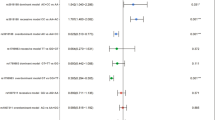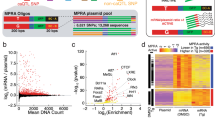Abstract
In the candidate gene approach, information about the distribution of single nucleotide polymorphisms (SNPs) is a crucial requirement for choosing efficient markers necessary for a case-control association study. To obtain such information, we discovered SNPs in 13 genes related to atherosclerosis by resequencing exon-flanking regions of 32 healthy Thai individuals. In total, 194 polymorphisms were identified, 184 of them SNPs, four insertions, and the rest deletions. Fifty-nine of the SNPs were characterized as novel polymorphisms, and these accounted for 30% of the identified SNPs. Comparing allele frequency distributions of the Thai population with other Asian populations shows similar patterns. In contrast, a low correlation pattern (r = 0.521) was found when comparing with either Caucasian or African populations. However, some rare alleles (rs11574541 and rs10874913) are found in the Thai population but not in other Asian populations. Most of the novel SNPs found were located outside the haplotype blocks generated by known SNPs in the Thai population. Only 5.77% of the novel SNPs lies in these defined haplotype blocks. The selection of haplotype-tagging SNPs shows that 8 of 13 genes benefited from the ethnic-specific genotype information. That is, when at least one novel SNP was present, the tagging SNPs chosen were altered. Functional prediction of 16 nonsynonymous SNPs (nsSNPs) by three different algorithm tools demonstrated that five nsSNPs possibly alter their corresponding protein functions. These results provide necessary information for conducting further genetic association studies involving the Thai population and demonstrate that resequencing of candidate genes provides more complete information for full genetic studies.
Similar content being viewed by others
Log in or create a free account to read this content
Gain free access to this article, as well as selected content from this journal and more on nature.com
or
References
Asztalos BF (2004) High-density lipoprotein metabolism and progression of atherosclerosis: new insights from the HDL Atherosclerosis Treatment Study. Curr Opin Cardiol 19:385–391
Barrett JC, Fry B, Maller J, Daly MJ (2005) Haploview: analysis and visualization of LD and haplotype maps. Bioinformatics 21:263–265
Brown CM, Rea TJ, Hamon SC, Hixson JE, Boerwinkle E, Clark AG, Sing CF (2006) The contribution of individual and pairwise combinations of SNPs in the APOA1 and APOC3 genes to interindividual HDL-C variability. J Mol Med V84:561–572
Carlson CS, Eberle MA, Rieder MJ, Smith JD, Kruglyak L, Nickerson DA (2003) Additional SNPs and linkage-disequilibrium analyses are necessary for whole-genome association studies in humans. Nat Genet 33:518–521
Cha PC, Yamada R, Sekine A, Nakamura Y, Koh CL (2004) Inference from the relationships between linkage disequilibrium and allele frequency distributions of 240 candidate SNPs in 109 drug-related genes in four Asian populations. J Hum Genet 49:558–572
de Bakker PI, Yelensky R, Pe’er I, Gabriel SB, Daly MJ, Altshuler D (2005) Efficiency and power in genetic association studies. Nat Genet 37:1217–1223
Department of Medical Service Thailand G (2006a) Statistical report. (http://www.dms.moph.go.th/statreport/index.html)
Department of Medical Service Thailand G (2006b) Statistical report of cardiovascular disease in Thai population. (http://www.dms.moph.go.th/statreport/2547/table0647.htm)
Disabella E, Grasso M, Marziliano N, Ansaldi S, Lucchelli C, Porcu E, Tagliani M, Pilotto A, Diegoli M, Lanzarini L, Malattia C, Pelliccia A, Ficcadenti A, Gabrielli O, Arbustini E (2006) Two novel and one known mutation of the TGFBR2 gene in Marfan syndrome not associated with FBN1 gene defects. Eur J Hum Genet 14:34–38
Do H, Vasilescu A, Diop G, Hirtzig T, Coulonges C, Labib T, Heath SC, Spadoni JL, Therwath A, Lathrop M, Matsuda F, Zagury JF (2006) Associations of the IL2Ralpha, IL4Ralpha, IL10Ralpha, and IFN (gamma) R1 cytokine receptor genes with AIDS progression in a French AIDS cohort. Immunogenetics 58:89–98
Fuki IV, Blanchard N, Jin W, Marchadier DH, Millar JS, Glick JM, Rader DJ (2003) Endogenously produced endothelial lipase enhances binding and cellular processing of plasma lipoproteins via heparan sulfate proteoglycan-mediated pathway. J Biol Chem 278:34331–34338
Gabriel SB, Schaffner SF, Nguyen H, Moore JM, Roy J, Blumenstiel B, Higgins J, DeFelice M, Lochner A, Faggart M, Liu-Cordero SN, Rotimi C, Adeyemo A, Cooper R, Ward R, Lander ES, Daly MJ, Altshuler D (2002) The structure of haplotype blocks in the human genome. Science 296:2225–2229
Hoh J, Matsuda F, Peng X, Markovic D, Lathrop MG, Ott J (2003) SNP haplotype tagging from DNA pools of two individuals. BMC Bioinform 4:14
Ishida T, Choi SY, Kundu RK, Spin J, Yamashita T, Hirata K, Kojima Y, Yokoyama M, Cooper AD, Quertermous T (2004) Endothelial lipase modulates susceptibility to atherosclerosis in apolipoprotein-E-deficient mice. J Biol Chem 279:45085–45092
Jaye M, Lynch KJ, Krawiec J, Marchadier D, Maugeais C, Doan K, South V, Amin D, Perrone M, Rader DJ (1999) A novel endothelial-derived lipase that modulates HDL metabolism. Nat Genet 21:424–428
Kim JY, Moon SM, Ryu HJ, Kim JJ, Kim HT, Park C, Kimm K, Oh B, Lee JK (2005) Identification of regulatory polymorphisms in the TNF-TNF receptor superfamily. Immunogenetics 57:297–303
Laukkanen J, Yla-Herttuala S (2002) Genes involved in atherosclerosis. Exp Nephrol 10:150–163
Maglott D, Ostell J, Pruitt KD, Tatusova T (2005) Entrez Gene: gene-centered information at NCBI. Nucleic Acids Res 33:D54–D58
Mahasirimongkol S, Chantratita W, Promso S, Pasomsab E, Jinawath N, Jongjaroenprasert W, Lulitanond V, Krittayapoositpot P, Tongsima S, Sawanpanyalert P, Kamatani N, Nakamura Y, Sura T (2006) Similarity of the allele frequency and linkage disequilibrium pattern of single nucleotide polymorphisms in drug-related gene loci between Thai and northern East Asian populations: implications for tagging SNP selection in Thais. J Hum Genet 51:896–904
Matyas G, Arnold E, Carrel T, Baumgartner D, Boileau C, Berger W, Steinmann B (2006) Identification and in silico analyses of novel TGFBR1 and TGFBR2 mutations in Marfan syndrome-related disorders. Hum Mutat 27:760–769
McCarthy JJ, Lehner T, Reeves C, Moliterno DJ, Newby LK, Rogers WJ, Topol EJ (2003) Association of genetic variants in the HDL receptor, SR-B1, with abnormal lipids in women with coronary artery disease. J Med Genet 40:453–458
McDermott DH, Yang Q, Kathiresan S, Cupples LA, Massaro JM, Keaney JF Jr, Larson MG, Vasan RS, Hirschhorn JN, O’Donnell CJ, Murphy PM, Benjamin EJ (2005) CCL2 polymorphisms are associated with serum monocyte chemoattractant Protein-1 levels and myocardial infarction in the Framingham Heart Study. Circulation 112:1113–1120
Michiels S, Danoy P, Dessen P, Bera A, Boulet T, Bouchardy C, Lathrop M, Sarasin A, Benhamou S (2007) Polymorphism discovery in 62 DNA repair genes and haplotype-associations with risks for lung, and head and neck cancers. Carcinogenesis (in press)
Mizuguchi T, Collod-Beroud G, Akiyama T, Abifadel M, Harada N, Morisaki T, Allard D, Varret M, Claustres M, Morisaki H, Ihara M, Kinoshita A, Yoshiura K, Junien C, Kajii T, Jondeau G, Ohta T, Kishino T, Furukawa Y, Nakamura Y, Niikawa N, Boileau C, Matsumoto N (2004) Heterozygous TGFBR2 mutations in Marfan syndrome. Nat Genet 36:855–860
Ng PC, Henikoff S (2002) Accounting for human polymorphisms predicted to affect protein function. Genome Res 12:436–446
R Development Core Team G (2006) R: a language and environment for statistical computing
Ramensky V, Bork P, Sunyaev S (2002) Human non-synonymous SNPs: server and survey. Nucleic Acids Res 30:3894–900
Rozen S, Skaletsky H (2000) Primer3 on the WWW for general users and for biologist programmers. Methods Mol Biol 132:365–386
Ruano G, Seip RL, Windemuth A, Zollner S, Tsongalis GJ, Ordovas J, Otvos J, Bilbie C, Miles M, Zoeller R, Visich P, Gordon P, Angelopoulos TJ, Pescatello L, Moyna N, Thompson PD (2006) Apolipoprotein A1 genotype affects the change in high density lipoprotein cholesterol subfractions with exercise training. Atherosclerosis 185:65–69
Schneider M, Tognolli M, Bairoch A (2004) The Swiss-Prot protein knowledgebase and ExPASy: providing the plant community with high quality proteomic data and tools. Plant Physiol Biochem 42:1013–1021
Simon DI, Chen Z, Seifert P, Edelman ER, Ballantyne CM, Rogers C (2000) Decreased neointimal formation in Mac-1−/− mice reveals a role for inflammation in vascular repair after angioplasty. J Clin Invest 105:293–300
Singh NN, Ramji DP (2006) The role of transforming growth factor-beta in atherosclerosis. Cytokine Growth Factor Rev 17:487–499
Tabara Y, Kohara K, Yamamoto Y, Igase M, Nakura J, Kondo I, Miki T (2003) Polymorphism of the monocyte chemoattractant Protein (MCP-1) gene is associated with the plasma level of MCP-1 but not with carotid intima-media thickness. Hypertens Res 26:677–683
Tabibiazar R, Wagner RA, Ashley EA, King JY, Ferrara R, Spin JM, Sanan DA, Narasimhan B, Tibshirani R, Tsao PS, Efron B, Quertermous T (2005) Signature patterns of gene expression in mouse atherosclerosis and their correlation to human coronary disease. Physiol Genom 22:213–226
Takahashi M, Matsuda F, Margetic N, Lathrop M (2002) Automated identification of single nucleotide polymorphisms from sequencing data. Proc IEEE Comput Soc Bioinform Conf 1:87–93
The Innate Immunity PGA P (2000) IIPGA genetic data: ITGAM allele frequencies. (https://innateimmunity.net/IIPGA2/PGAs/InnateImmunity/ITGAM/allele_freqs?flavor=masked)
The International HapMap C (2005) A haplotype map of the human genome. Nature 437:1299–1320
Wang X, Le Roy I, Nicodeme E, Li R, Wagner R, Petros C, Churchill GA, Harris S, Darvasi A, Kirilovsky J, Roubertoux PL, Paigen B (2003) Using advanced intercross lines for high-resolution mapping of HDL cholesterol quantitative trait loci. Genome Res 13:1654–1664
Yue P, Melamud E, Moult J (2006) SNPs3D: candidate gene and SNP selection for association studies. BMC Bioinform 7:166
Acknowledgments
We thank Justin Dantzer for designing figures used in this article and Lang Li and Jeesun Jung for helpful advice. CT received the postdoctoral fellowship from the National Center for Genetic Engineering and Biotechnology, Thailand, under the Thailand SNP Discovery Project. SP is funded by Thailand Center for Excellence in Life Sciences (TCELS) under the Postdoctoral Scholarships Program. SDM is funded by NIH K22LM009135.
Author information
Authors and Affiliations
Corresponding author
Additional information
Chintana Tocharoentanaphol and Somying Promso contributed equally to this work.
Rights and permissions
About this article
Cite this article
Tocharoentanaphol, C., Promso, S., Zelenika, D. et al. Evaluation of resequencing on number of tag SNPs of 13 atherosclerosis-related genes in Thai population. J Hum Genet 53, 74–86 (2008). https://doi.org/10.1007/s10038-007-0220-8
Received:
Accepted:
Published:
Issue date:
DOI: https://doi.org/10.1007/s10038-007-0220-8
Keywords
This article is cited by
-
VarDetect: a nucleotide sequence variation exploratory tool
BMC Bioinformatics (2008)
-
Genomic medicine and developing countries: creating a room of their own
Nature Reviews Genetics (2008)



